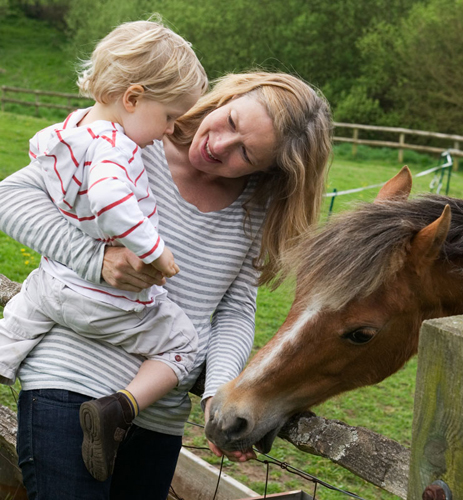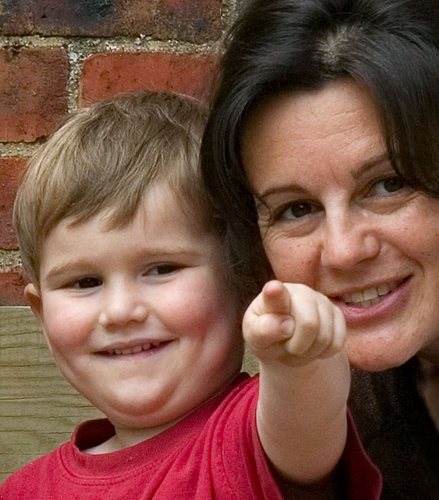Your toddler needs to learn to communicate so that he
can relate to other people and develop the social and inter-personal
skills that are so important for building friendships and being
understood. He relies on nonverbal, verbal, and listening skills and in
many ways operates at an intuitive level.
“Karl is a real chatter-box. His conversations are a lovely mix of fantasy and reality.”
—“Karl is a real chatter-box. His conversations are a lovely mix of fantasy and reality.”
“Be aware of the power of
your body language. When you praise your toddler verbally you need to
look and act like you are interested, too!”
Much of what is now
referred to as emotional intelligence has its roots in our childhood
experience of learning language and communication skills. What we say to
our children is important, but so is: our choice of language, tone of
voice, how we ask questions, how we listen to their replies, what we
hear, how we respond, whether we empathize, and how our body language
echoes or contradicts what we are saying.
Being inquisitive
He will begin to converse with you by making comments and asking
questions. Take time to talk to him and give him the opportunity to
respond.

The art of toddler conversation
Now that your toddler’s
memory is so much more developed and he is able to use his imagination
to cope with the idea that one thing (such as a doll) can represent
another (such as a baby), his language skills will quickly develop and
he will be ready to start having conversations.
When we talk, we use
words to represent the things we want to talk about, so the word “apple”
represents the fruit, even if there is no apple in sight. Your toddler
is beginning to understand this and is developing the ability to link
the right word to the right object simultaneously. He can remember and
talk about things that he can’t see, and his newfound ability to take
turns in conversation means that he is getting more used to being able
to listen to what you say and then respond to you.
At the age of two,
however, your toddler is still unable to hold lots of information in his
mind at one time, so his conversations may not follow a logical
sequence, and he will probably answer no more than one in three
questions, as the following sequence between Aaron, age two-and-a-half,
and his daddy, shows:
Daddy “What would you like to do today, Aaron? Would you like to go to the park? Or would you like to play a game?”
Aaron “I play with Daddy.”
Daddy “That’s a nice idea. What game would you like to play, Aaron?”
Aaron “Mommy goed in car.” Aaron has split his focus of attention.
Daddy “Yes, she has gone shopping in the car.”
Your toddler will also begin to realize when he has not understood something, and will start to ask for clarification.
“Aaron, would you like to come to watch me play football?”
Aaron nods and says “Aaron come play.”
Daddy “No, Daddy will play football. Aaron will watch Daddy play.”
Aaron looks puzzled and says “Huh?”
You can help your child understand how to make things clearer by asking him to repeat what he has said.
Daddy “So, Aaron, would you like to come with me?”
Aaron “Yes.”
Daddy “And what are we going to do?”
Aaron, smiling, says “Me watch Daddy play foo’ball.”
Daddy “That’s right, Aaron. You can come and watch.”
Aaron pauses, and then grins and repeats “Me watch Daddy play foo’ball … and me have ice cream.”
Daddy, laughing, says “We’ll see about the ice cream later!”
Aaron “Huh?” He is seeking clarification.
By the time Aaron is three
years old, the same conversation will become strikingly different.
Instead of saying “me watch” and “Mommy goed” he will probably be able
to use “I” correctly and will have a better understanding of how to use
words in the past tense. He is very likely to be able to say: “Mommy
went shopping, Daddy. In the car,” and “I come and watch you play
football.” Toddlers can never have too much conversation time with
Mommy, Daddy, or anyone interested enough to talk to them. It is
valuable to make special time to talk to your toddler and have a real
conversation, rather than talking absentmindedly while doing other
things. First thing in the morning, after coming home from work, while
eating a meal, or at bedtime: all these are ideal private times for
uninterrupted talk.
Learning about feelings
Communication is
about body language, too. Every hug, kiss, glance, smile, frown, or
laugh sends a clear message to your toddler and tells him how you feel
about him, what sort of mood you are in, and what kind of response you
are expecting. He probably knows your body language better than you do,
but make sure that your nonverbal signals match your words. Having your
hands on your hips while saying “well done”, or saying “good boy” with a
frown on your face, is likely to confuse your child and send him a
mixed message.
Are you in tune with what
he is saying to you? Watch his facial expressions and physical stance
when he is talking to you. Does his voice match his body language? If
his eyes and stance say one thing and his words say another, gently
encourage and help him to try to tell you how he feels. Toddlers know
the power of eye contact and are able to win over a total stranger at 10
yards in a checkout line, simply by staring and smiling. However, his
language skills are not as mature and he will need your help in learning
how to translate his mood and feelings into words.
How language develops
How we learn language
is not fully understood, although the work of linguistic experts such as
Noam Chomsky and Jerome Bruner (see Make language learning fun)
plays an important role in our current beliefs and understanding. It
can be helpful to know that when your toddler speaks he is actually
grappling with four different areas of language development,
simultaneously.
These four areas are:
That is a lot for a
developing brain to take on board, so it is no wonder that your toddler
gets frustrated sometimes. When he is older he will learn his letters,
spelling, and grammar, how to use tone of voice appropriately, and how
to use language sensitively. But for now he is concentrating on building
his memory bank of words so that he has enough words to choose from to
be able to communicate at a basic level.
During year 2–3, his
language skills will race ahead. First of all, his phrases will lengthen
from two words to three or four. Instead of “Daddy work” he might
announce at 24 months, “Daddy go work now,” and by 36 months may have
progressed to, “Daddy going to work now.” By 30 months he will be able
to use the personal pronouns “I,” “me,” and “you” in the correct way. He
will probably develop his own shortened version of some words and
phrases, often based on the beginnings and endings of words, such as
“chocake” for chocolate cake, or “su-ket” for supermarket. (Obviously
some words just have too many syllables to be useful!) He will also
start to learn how to ask questions, often by simply adding “Why?” to
his sentence. Before he might have observed that, “The baby cry.” Now,
at 24 months, he is asking you, “Why baby cry?” and by 36 months he
might say, “Why baby crying?”
Probably the words with
the most impact, however, are your toddler’s understanding of the
importance of “Yes” and the overwhelming power of “No.” Over the weeks
ahead you will probably hear the words “No” and “Why” more often than
you would have thought possible.
How to use sounds and how to pronounce words (phonemics).
How
to understand individual meanings of words and learn to use them in a
way that makes sense, such as using plurals or the past tense
(semantics).
How to combine several words into sentences in a logical order and a meaningful way (syntax).
How language is used in different situations and contexts (pragmatics).
Language development—taught or caught?
Until the late 1950s
there was a common belief that children learned language on an
individual basis, either by hearing and imitating sounds or by
interpreting other people’s responses to sounds. The linguistic expert
Noam Chomsky believed that this was too simplistic to explain the
complex process of learning the meaning, structure, and grammatical
rules of language. He pointed out that children as young as three will
show awareness of grammatical rules, such as making plurals.
He also pointed out that
children show a clear pattern of language development across different
cultures and this could not be the case if all language was individually
taught. Chomsky believed that we have an inborn ability to learn the
rules and meanings of any language from birth, depending on what we are
exposed to. He pointed out that all children, whatever their cultural
roots, show similar errors at different stages of language development,
which are the result of getting used to grammatical structure.
Chomsky’s ideas were
developed further by Jerome Bruner in the 1980s. He believed that
language results from a combination of innate ability plus exposure to
language in our personal environment. Social interaction starts when, as
a small baby, your child learns to direct his gaze to where you are
looking. By 12–18 months he learns to look at objects not only from his
own perspective, but also to move position, to see what you are looking
at. Bruner and others argue that this stage connects to language
development. This is the point where a child first starts to share
meaning with another, as this example shows:
Daddy “Look at the beautiful green bird, Tariq.” Tariq looks, but he can’t see a bird.
Daddy, pointing, says “There, look, on the tree.” Tariq follows the direction of his Daddy’s pointing finger.
Tariq
“I see bird! I see green bird, Daddy.” Tariq is saying, if I look where
you look, I can share your perspective and understand what you mean.
Sharing the meaning of
words and a point of focus is known as “joint attention”. Once a child
can manage this he becomes ready and willing to communicate and
converse, and will start to develop ways to do so.
I can see it, too!
Once your toddler learns to look where you look, he can begin to
learn the meaning of words by both verbal and nonverbal means, such as
pointing.
